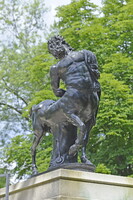| dc.coverage.spatial | Site: Cranbrook Educational Community (Bloomfield Hills, Michigan, United States) | en_US |
| dc.coverage.temporal | originals ca. 117-138 CE (creation) | en_US |
| dc.creator | Aristeas | en_US |
| dc.creator | Papias | en_US |
| dc.date | 117-138 | en_US |
| dc.date.accessioned | 2016-08-23T18:13:15Z | |
| dc.date.available | 2016-08-23T18:13:15Z | |
| dc.date.issued | 117-138 | en_US |
| dc.identifier | 267903 | en_US |
| dc.identifier.other | archrefid: 3247 | en_US |
| dc.identifier.uri | http://hdl.handle.net/1721.3/184217 | |
| dc.description | Overall view from below, in front of gate; The Furietti Centaurs (known separately as the Old Centaur and Young Centaur) are a pair of Hellenistic or Roman grey-black (bigio morato) marble sculptures of centaurs based on Hellenistic models, now in the Capitoline Museum. The amorini are missing that once rode the backs of these centaurs (this is a Roman Dionysiac motif). The sculptures were found together at Hadrian's Villa in Tivoli by Monsignor Giuseppe Alessandro Furietti in December 1736. Both statues bear the signatures of Aristeas and Papias of Aphrodisias, a city in Asia Minor. Aphrodisias had a school of skillful copyists of Greek works. In the last decades of the first century CE, some of these artists moved to Rome. The Hadrianic copies date to the late 1st or early 2nd century CE. They are generally assumed to be copies of 2nd century BCE bronze Hellenistic originals, but may be Roman inventions. These examples, purchased in 1927 by Cranbrook founder George Booth, are contemporary bronze reproductions. Source: Wikipedia; http://en.wikipedia.org/wiki/Main_Page (accessed 7/17/2015) | en_US |
| dc.format.medium | bronze | en_US |
| dc.rights | © Scott Gilchrist, Archivision, Inc. | en_US |
| dc.subject | mythology (Classical) | en_US |
| dc.subject | mythical creatures | en_US |
| dc.subject | Hellenistic | en_US |
| dc.subject | Greco-Roman | en_US |
| dc.title | Old Centaur (reproduction of Furietti Centaurs from Tivoli) | en_US |
| dc.title.alternative | Old Centaur | en_US |
| dc.type | image | en_US |
| dc.rights.access | Licensed for educational and research use by the MIT community only | en_US |
| dc.identifier.vendorcode | 6A2-US-BH-OT-A11 | en_US |
| vra.culturalContext | Roman (ancient) | en_US |
| vra.technique | casting (process) | en_US |
| vra.worktype | sculpture (visual work) | en_US |
| vra.worktype | replica | en_US |
| dc.contributor.display | after Aristeas (Roman (ancient) copyist, active 2nd century CE); after Papias (Roman (ancient) copyist, active 2nd century CE) | en_US |


